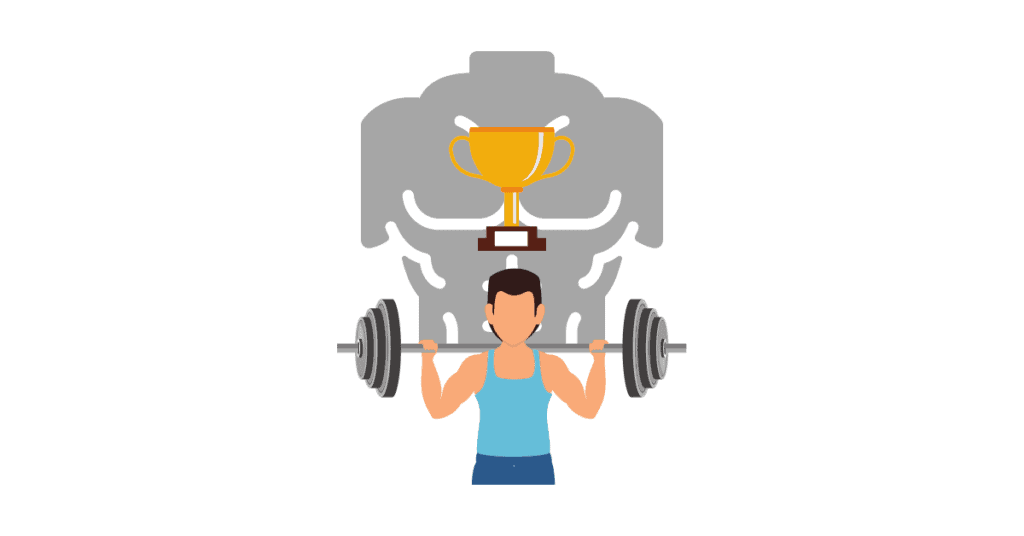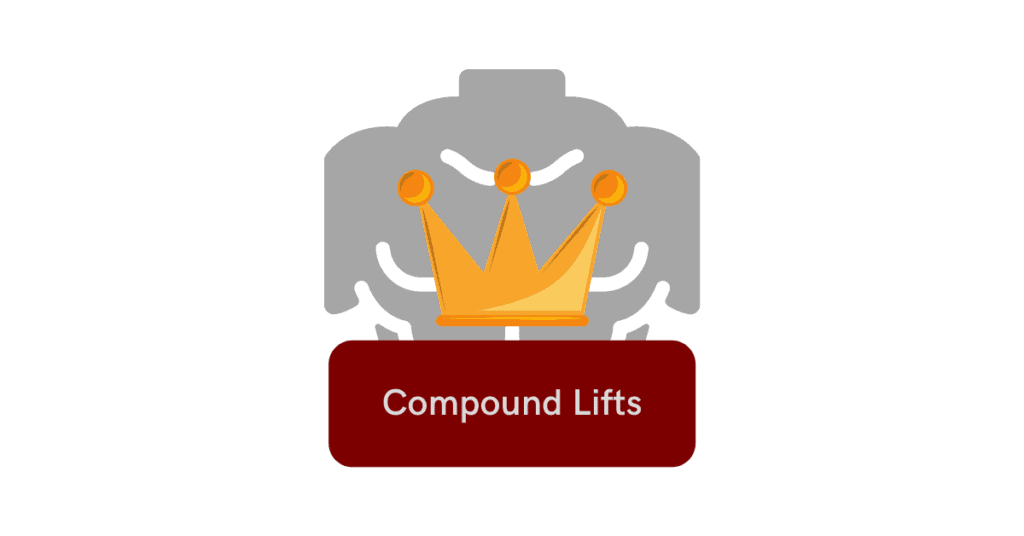Are you currently lifting weights or looking to start lifting weights, but just don’t know where to start? Look no further! Because today, I will be teaching you how to lift weights properly.
Lifting weights properly requires a weight that fatigues the muscle within your chosen rep range. Good form is also essential and is achieved by lifting the weight in a slow and controlled manner, without using body momentum to help lift the weight. This ensures the target muscle is engaged.
2 years ago, I was the new skinny kid at the gym. And I still vividly remember how overwhelming it can be to get started. This is why I am sharing my insights and experiences with you today!
So put on your study hat and…
LET’S GO!
- 1. Identify An Overall Goal To Lift Weights Properly
- 2. Create A Goal-Based Weight Training Programme
- 3. Include Appropriate Weight Lifting Exercises In Your Programme
- 4. Determine A Suitable Rep/Set Range
- 5. Choose A Proper Weight-Load
- 6. Adopt A Suitable Weight Lifting Method
- 7. Learn Exercise Form To Lift Weights Properly
- 8. Warm-Up Properly Before Lifting Weights
- 9. Choose Suitable Weight Lifting Equipment
- 10. Go Slow And Controlled To Lift Weights Properly
- 11. Control Your Breathing To Lift Weights Properly
- 12. Use Proper Weight Lifting Range Of Motion
- 13. Concentrate On Proper Mind To Muscle Contractions
- 14. Overload The Muscle Regularly
- Conclusion

1. Identify An Overall Goal To Lift Weights Properly

The very first thing you need to do is to establish your overall goal. Your final destination.
To put it another way, what do you expect to gain from your weight training?
Goal-setting is essential. By establishing your goal, you are setting yourself up to lift weights properly. This is because different goals dictate different training methods.
In other words, a person lifting weights to burn fat will adopt a different training method to someone lifting weights to gain muscle.
Now, as a skinny guy, your goal will probably be the latter. You are most likely looking to gain some muscle.
By clearly identifying your overall goal, you can create a goal-based training program.
2. Create A Goal-Based Weight Training Programme

Now that you have established your training goal, you can create a training program. And the program should be focused entirely on helping you achieve your goal.
I would highly recommend that you keep a record of your program. And this can be done via a simple note-pad and pen or an Excel spreadsheet.
Here are the different variables you should be recording in your training program:
- Weight lifting exercise type.
- Reps and sets lifted.
- Weight-load lifted.
- Difficulty (was it hard? Easy? Just about right?)
By following a program, you will increase the likelihood of reaching your goal. Additionally, keeping records allows you to troubleshoot any future issues.
Now I will explain how to determine these 4 variables.
3. Include Appropriate Weight Lifting Exercises In Your Programme

Firstly, the exercises you choose to perform should be tailored to your goal.
If you are looking to lift weights to build muscle, then I would recommend including compound exercises. In fact, these exercises are generally considered to be the skinny guy’s cheat code to gain muscle fast!
For this reason, compound exercises should be the focus of your muscle-building training program. And in my opinion, the following compound lifts should be a staple addition to any skinny guy’s program:
- Bench press.
- Overhead press.
- Barbell row.
- Pull/chin-up.
- Deadlift.
- Squat
In fact, performing these 6 exercises alone should be sufficient to achieve your goal of building muscle! That being said, a suitable muscle-building diet plan will also be required.
4. Determine A Suitable Rep/Set Range

Secondly, you will need to decide on suitable reps and sets to help you achieve your goal
So what is a rep and set?
A rep is simply the number of continuous repetitions you complete for a specific exercise, without a break. A group of reps would then form a set. And you would typically rest for 2 to 3 minutes between sets.
If your goal is to build muscle mass mass, then I would recommend starting at 10 sets per body part per week.
Additionally, this should be spread over 3 to 4 training days, which equates to around 3 sets per muscle group per training session. Furthermore, each set should consist of 8 to 12 reps.
In short, this rep/set range is optimal for muscular hypertrophy (increasing muscle size).
5. Choose A Proper Weight-Load

Finally, you will now need to decide how much weight to lift for each exercise.
For muscular hypertrophy, the generally recommended weight is 60-80% of your 1 rep max. In other words, choose a weight that is 60-80% of the maximum weight you can lift for 1 repetition for that given exercise.
Now, this can be difficult to judge for beginners. And if you are unsure about choosing the correct starting weight, you can use a trial-and-error method.
This simply involves experimenting with different weights until you find one which challenges you for 8 to 12 repetitions.
6. Adopt A Suitable Weight Lifting Method

Now, you will need to adopt a suitable weight-lifting method to lift weights properly.
You may have already come across many different weight lifting methods such as straight sets, drop sets, pyramid sets, super sets, time under tension, etc, etc.
But as a beginner, I would simply concentrate on straight sets. In fact, focus on straight sets and forget the rest (for now)!
This is because straight sets are simple to perform. Additionally, traditional straight sets are more than adequate for you to build muscle.
Straight sets simply involve completing a set, taking a 2 to 3-minute rest, then repeating for around 3 total sets.
7. Learn Exercise Form To Lift Weights Properly

Practicing weight lifting form is essential for a skinny beginner who is learning how to lift weights properly!
This is because good form will reduce the risk of injury, maximize training benefits, and minimize energy spent on wasted motion.
In other words, learning proper form will allow you to build bigger muscles quickly and safely!
Examples of good form include:
- Moving through the full range of motion.
- Lifting a weight with proper target muscle contraction.
- Minimizing body momentum to help lift a weight.
- Keeping your joints and spine aligned during a lift.
Youtube channels are a good resource for learning form without a personal trainer. Look for recent videos which have a high view count and rating.
Alternatively, you can use lifting databases to search for your exercise(s) of interest!
8. Warm-Up Properly Before Lifting Weights

Warming up is essential to lift weights properly.
An effective warm-up will reduce the risk of injury, as well as improve your lifting capabilities.
Again, this will help you to build muscle quickly and safely!
So how can you warm up for weight lifting?
First, I would recommend a general warm-up. This consists of dynamic stretching, joint rolling exercises, and very light cardio.
Then, you can perform 3 to 5 warm-up sets using high reps with a low weight. And this will prepare the muscles for your workout sets.
9. Choose Suitable Weight Lifting Equipment

Weight lifting is an extremely flexible form of exercise. Not only are there different exercises you can perform, but there are also different types of equipment.
Additionally, the different types of equipment have their own pros and cons.
As a skinny beginner, I would highly recommend practicing with resistance bands and weight machines. These are generally safer and more beginner friendly than free weights.
After you have mastered your lifting form and built some strength, you can then safely move onto the dumbbells and barbells!
10. Go Slow And Controlled To Lift Weights Properly

No matter what equipment type you choose to lift with, always make sure you lift in a slow and controlled manner. And there are two main reasons for this.
Firstly, lifting slowly and controled makes it easier to maintain good form. And good form reduces injury risk and maximizes muscle contraction (as explained above).
Secondly, a study has shown that reducing lifting speed is actually more beneficial for muscle strength gains.
I would personally recommend counting for 2 seconds on the upward phase, pausing for a second at peak contraction, and then counting for another 2 seconds on the downward phase.
11. Control Your Breathing To Lift Weights Properly

I know this may sound silly, but don’t forget to breathe when you are weightlifting!
Many beginners fail to control their breathing when they begin weightlifting. And even worse, some will unintentionally hold their breath!
This is no good.
Not only can this be dangerous, but it will also limit the oxygen supply to the muscles. And this will have negative consequences for making muscle gains.
It is generally recommended to exhale during the upward phase of a lift and inhale during the downward phase. Additionally, controlled breathing will help you to maintain good lifting form.
12. Use Proper Weight Lifting Range Of Motion

Range of motion refers to the extent of movement around a joint. And when you are lifting weights, you should be lifting with a full range of motion.
In other words, complete a movement as much as your joints will anatomically allow you to.
Let’s use a bench press as an example- the upward phase should end with your arms fully extended (but not locked), whilst the downward phase should end with the hands at just-above-chest level.
A full range of motion is important because it will present a maximal stimulus to your muscle fibers. And this, in turn, will facilitate muscle growth.
13. Concentrate On Proper Mind To Muscle Contractions

Mind to muscle contraction refers to the conscious engagement of a muscle during a lift.
Again, this may sound silly to beginners. But many people actually lift weights based on pre-learned movement patterns. In other words, their subconscious is partly driving the movement.
In comparison, mind to muscle contraction advocates you to make an active effort to maximally contract the target muscles.
So what does this look like?
If we take the bench press example again- by contracting your shoulder blades and slightly arching your back, you can focus the push exclusively on the pectorals. Additionally, you could hold the movement for a second at peak contraction.
Therefore, engage in mind muscle contraction to help you maximize the muscle-building benefits of your workouts.
14. Overload The Muscle Regularly

Overloading a muscle simply involves increasing lifting intensity. And this is important to continue making fast muscle gains from weight lifting.
There are many ways to overload. But the most simple and time-effective way is to add more weight.
By adding more-weight, you are presenting a more challenging stimulus to your muscle. And as a result, the muscle will grow in strength and size.
As a beginner, aim to overload with a small amount of weight (1 to 5 pounds) when your current reps and sets become easier to complete.
And I stress the words small amount of weight (don’t bite off more than you can chew!).
Conclusion
There we have it!
Today, I have given you my step-by-step guide on how to lift weights properly to gain muscle as a skinny guy.
I have explained the importance of creating a goal-based weight training program, described the best and safest methods to maximize muscle growth, and explained how you can make continued muscle gains into the future.
Did my step-by-step weight-lifting guide give you more confidence to lift weights?
Feel free to send me a message if you have any questions! You can find my details on the “contact us” page.
You may also be interested in the downloadable Kalibre Blueprint PDF which details exactly how I gained 40lbs of lean muscle (it’s 100% free!). It details the exact exercises and nutrition (with printable worksheets) I used to go from skinny to ripped!
Thanks for reading guys!
Peace Out,
Kal
(Biochemistry BSc, Biomedical Sciences MSc, Ex-Skinny Guy)


